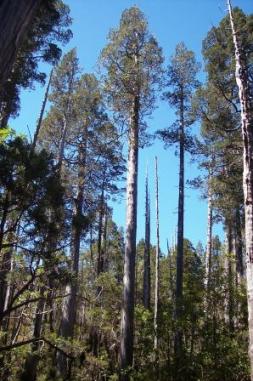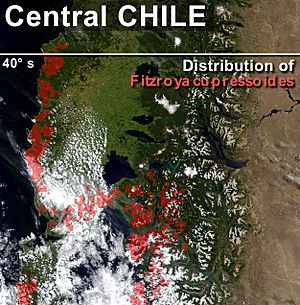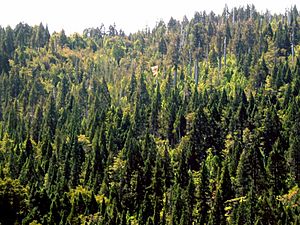Fitzroya facts for kids
Quick facts for kids Fitzroya |
|
|---|---|
 |
|
| Conservation status | |
| Scientific classification | |
| Genus: |
Fitzroya
|
| Species: |
cupressoides
|
 |
|
| Distribution of F. cupressoides in South-Central Chile (red) | |
The Fitzroya is a special type of tree that belongs to the cypress family. There is only one living species, called Fitzroya cupressoides. This tree is very tall and lives for a long time. It grows naturally in the Andes mountains and near the coast in southern Chile. You can also find it in the Argentine Andes. It is an important part of the Valdivian temperate forests.
People call this tree by different names. In Spanish, it's often called alerce, which means "larch". Another Spanish name is lahuán, which comes from the Mapuche word lawal. It's also known as the Patagonian cypress. The tree's scientific name, Fitzroya, honors Robert FitzRoy.
Contents
Amazing Facts About the Fitzroya Tree
The Fitzroya cupressoides is the biggest tree species in South America. It usually grows to be 40 to 60 meters (about 130 to 200 feet) tall. Some trees can even reach over 70 meters (230 feet) tall! Their trunks can be as wide as 5 meters (16 feet) across.
The top part of the tree, called its canopy, is shaped like a rough pyramid. It provides shade for other plants like the southern beech, laurel, and myrtle trees. The largest known living Fitzroya is called Alerce Milenario. It is found in Alerce Costero National Park in Chile. This giant tree is more than 60 meters tall and its trunk is 4.26 meters (14 feet) wide.
Much larger trees existed before many were cut down in the 1800s and 1900s. Charles Darwin once wrote about finding a Fitzroya tree with a trunk 12.6 meters (41 feet) wide!
Leaves and Cones
The leaves of the Fitzroya tree grow in groups of three, like a spiral staircase. They are about 3 to 6 millimeters long. On young trees, they can be up to 8 millimeters long. Each leaf has two white lines on it, which are tiny pores called stomata. These pores help the tree breathe.
Fitzroya trees are special because they are dioecious. This means that male and female cones grow on different trees. The cones are round, about 6 to 8 millimeters wide. When they open, they become flat, about 12 millimeters across. They have nine scales arranged in three groups of three. Only the middle group of scales can produce seeds. Each of these scales holds 2 to 3 seeds. The seeds are flat, 2 to 3 millimeters long, and have a wing on each side. The seeds are ready about 6 to 8 months after the tree is pollinated.
The bark of the Fitzroya cupressoides is very thick. Scientists think this thick bark might help the tree survive forest fires.
Oldest Trees and Fossils
In 1993, a Fitzroya tree in Chile, known as "Gran Abuelo" or "Alerce Milenario," was found to be 3,622 years old. This makes it the second oldest living tree species that has been fully checked by counting its growth rings. Only the bristlecone pine is known to be older.
Scientists have also found fossilized leaves of a Fitzroya species in Tasmania, Australia. These fossils are about 35 million years old. This discovery shows that long ago, the plants in Australia and southern South America were very similar. This is part of what botanists call the Antarctic flora.
About 40,000 to 50,000 years ago, during warmer periods of the Ice Age, Fitzroya trees grew in a much larger area. They were found in places like the lowlands of Chiloé Island and west of Llanquihue Lake. Today, most Fitzroya trees grow higher up in the mountains. Trees found near sea level are likely remnants from those ancient times.
History of the Fitzroya Tree
The wood of Fitzroya cupressoides has been used for a very long time. Wood from this tree was found at the Monte Verde site, showing it was used at least 13,000 years ago. The Huilliche people used the wood to make tools and weapons.
When the Spanish arrived in the Chiloé Archipelago in 1567, most of the islands were covered in thick forests where F. cupressoides grew. The wood became very important for the economy in colonial Chiloé and Valdivia. They would send large wooden planks to Peru. One single tree could provide 600 planks, each at least 0.5 meters wide and 5 meters long. The wood was highly valued in Chile and Peru because it was flexible and light.
After the city of Valdivia was destroyed in 1599, Chiloé became even more important. It was the only place that could supply the Viceroyalty of Peru with F. cupressoides wood. The first big shipment left Chiloé in 1641.
The wood of Fitzroya cupressoides was the main item traded with Peru. It even became a type of local currency in the Chiloé Archipelago, known as the real de alerce. Some historians believe that the Spanish settlement in Chiloé survived better than others in Southern Chile because of how important the alerce wood trade was.

From about 1750 to 1943, when the land between the Maullín River and Valdivia was settled, many Fitzroya forests in Cordillera Pelada caught fire. These fires were started by Spanish, Chilean, and European settlers. Before that, from 1397 to 1750, the Fitzroya forests in Cordillera Pelada also had fires caused by lightning strikes and by local people.
In the 1850s and 1860s, a man named Vicente Pérez Rosales oversaw the clearing of huge areas of forest. This was done to create open land for German settlers in Southern Chile. The fires he started affected a long strip of land in the Andean foothills. One famous intentional fire was in the Fitzroya forests between Puerto Varas and Puerto Montt in 1863. This was done during a drought. Clearing forests was often necessary for settlers to survive, as they relied on farming.
Cutting down Fitzroya trees continued until 1976. At that time, a law was passed to protect the trees, making it illegal to cut them down. However, sometimes illegal logging still happens, even today.
See also
 In Spanish: Alerce Patagónico para niños
In Spanish: Alerce Patagónico para niños
- List of superlative trees
- Ñadi
Images for kids






